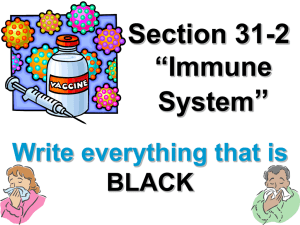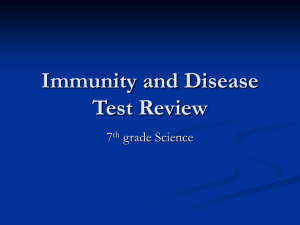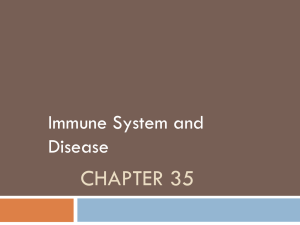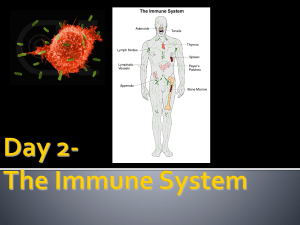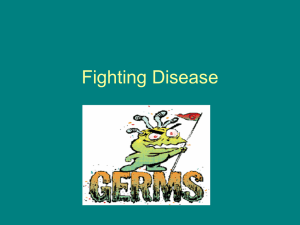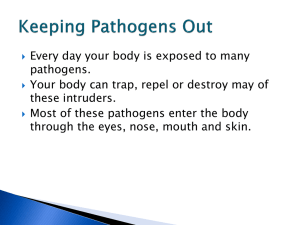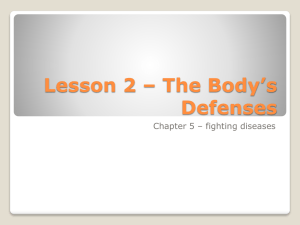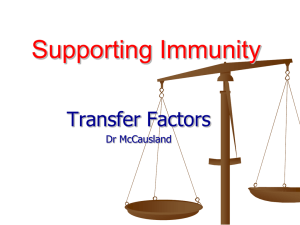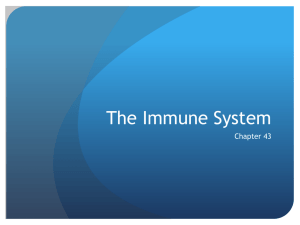C23L3 PPT - Destiny High School
advertisement
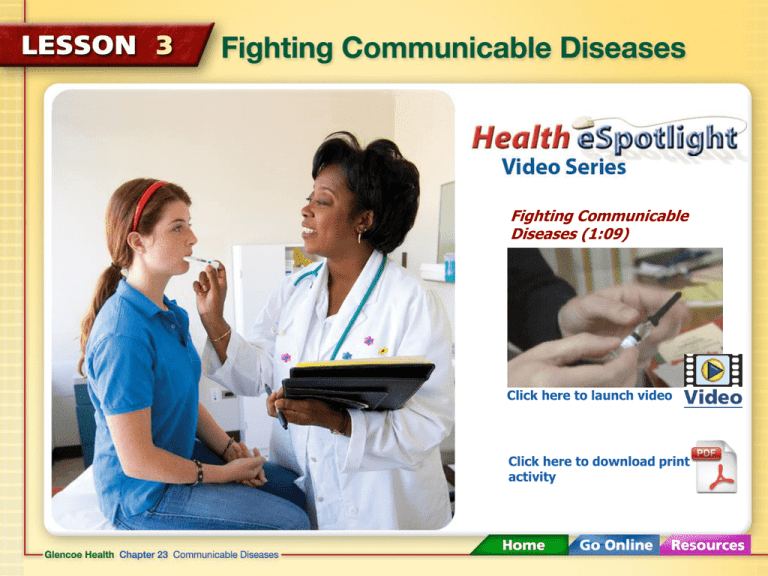
Fighting Communicable Diseases (1:09) Click here to launch video Click here to download print activity Do Now: Pick 4 Words and write down the definition. immune system – Pg. 639 Immunity – Pg. 640 inflammatory response – Pg. 640 Lymphocyte – Pg. 640 Phagocytes – Pg. 640 Antibody – Pg. 641 Antigens – Pg. 640 Vaccine – Pg. 641 Today’s Objectives • Explain how physical and chemical barriers protect the body against pathogens. • Describe the inflammatory response. • Explain the role of phagocytes. • Explain the difference between active and passive immunity. By learning about and practicing prevention strategies, you can help your body stay healthy. Physical and Chemical Barriers Physical and chemical barriers make up your body’s first line of defense against pathogens. Your body has its own built-in barriers to handle invasion from microscopic pathogens. Physical and Chemical Barriers Physical barriers, such as the skin, block pathogens from invading your body. Chemical barriers, such as the enzymes in tears, destroy those invaders. Physical and Chemical Barriers Tears and saliva contain enzymes that disable and even destroy pathogens. Physical and Chemical Barriers Mucous membranes form a protective lining for your mouth, nose, and many other parts of your body. These membranes trap pathogens and carry them to other parts of the body for disposal. Physical and Chemical Barriers Skin is like a personal coat of armor, stopping most pathogens in their tracks as they try to enter the body. Physical and Chemical Barriers Cilia are small hairs that line parts of your respiratory system. Cilia sweep mucus and pathogens to the throat, where they can be swallowed or coughed out. Physical and Chemical Barriers Gastric juice in the stomach destroys many pathogens that enter your body through the nose or mouth. The Immune System Your body’s immune system is your best ally in the fight against communicable diseases. Some pathogens can get past your body’s physical and chemical barriers. The Immune System The immune system fights pathogens using two major strategies: the inflammatory response and specific defenses. Immune system A network of cells, tissues, organs, and chemicals that fights off pathogens The Inflammatory Response When a splinter or a cut becomes becomes red and swollen, these are symptoms of the inflammatory response. Inflammatory response A reaction to tissue damage caused by injury or infection The Inflammatory Response 1 Blood vessels near the injury expand to allow more blood to flow to the area. 2 Fluid and cells from the bloodstream cause swelling and pain because of pressure on the nerve endings. 3 Phagocytes surround the pathogens and destroy them with special chemicals. 4 With the pathogens killed and tissue damage under control, the body begins to repair the tissue. The Inflammatory Response Pus, a mass of dead phagocytes and damaged tissue, may build up at the site of inflammation as a response to bacteria. Phagocytes White blood cells that attack invading pathogens Specific Defenses The immune system triggers the immune response in reaction to pathogens that survive. Specific Defenses When the immune system recognizes a particular pathogen, it activates specific defenses in an attempt to prevent this type of infection from occurring again. Specific Defenses Specific Defenses During the immune response, your immune system reacts quickly to antigens. Antigens Substances that can trigger an immune response Specific Defenses When you have immunity, you have biological defenses to avoid infection or disease. Immunity The state of being protected against a particular disease Lymphocytes Lymphocytes play an important role in the immune response. There are two types of lymphocytes: T cells and B cells. Lymphocytes A specialized white blood cell that coordinates and performs many functions of specific immunity T Cells Helper T cells Trigger the production of B cells and killer T cells Killer T cells Attack and destroy infected body cells but do not attack the pathogens Suppressor T cells Suppress, or “turn off,” helper T cells when the infection has been cleared B Cells Each B cell is programmed to make one type of antibody that is specific to a certain pathogen. Antibody A protein that acts against a specific antigen B Cells The different purposes of antibodies include attaching to antigens to mark them for destruction. destroying invading pathogens. blocking viruses from entering body cells. Immune System Memory Your immune system “remembers” the antigens it has dealt with in the past. When antigens activate certain T cells and B cells, the cells become memory lymphocytes. Immune System Memory The lymphatic system is part of your immune system. It includes your tonsils, lymph nodes, and a network of vessels, similar to blood vessels, that transport lymph, or tissue fluid. Lymph nodes can become enlarged when your body is fighting an infection because of the increased number of lymphocytes. If swelling lasts for three days, see your health care professional. Lymphocytes are produced by lymph nodes. These nodes occur in groups and are concentrated in the head and neck, armpits, chest, abdomen, and groin. Immune System Memory Your immune system’s memory not only identifies invading pathogens. It also helps you develop immunity from certain diseases. There are two types of immunity: active and passive. Active Immunity Your body develops natural active immunity when it is exposed to invading pathogens. Artificially acquired active immunity is developed from a vaccine. Vaccine A preparation of dead or weakened pathogens that are introduced into the body to stimulate an immune response Active Immunity For some diseases you only need to be vaccinated once in your life. For other diseases you need to be vaccinated at regular intervals. Passive Immunity Passive immunity is temporary, usually lasting only a few weeks or months. Passive Immunity Natural passive immunity occurs when antibodies pass from mother to child during pregnancy or while nursing. Passive Immunity Artificial passive immunity happens when you receive an injection prepared with antibodies that are produced by an animal or a human immune to the disease. Prevention Strategies Strategies for preventing the spread of disease include practicing healthful behaviors, tracking diseases, and getting vaccinations. Prevention Strategies Eat a nutritious, well-balanced diet. Get regular physical activity. Wash your hands frequently. Handle food properly. Avoid insect bites. Abstain from sexual contact. Tracking Reportable Diseases Community, national, and global health agencies track communicable diseases and predict where the diseases might strike next. This information helps countries prepare and develop their own prevention strategies. Vaccinations Live-virus vaccines are made from pathogens grown in laboratories. Killed-virus vaccines are made from dead pathogens. Toxoids are made from inactivated toxins from pathogens. New and second-generation viruses are made with genetically altered cells. Immunization for All Vaccination reduces the number of people who are at risk for a communicable disease. That’s why it’s important to keep your immunizations up-to-date. END Exit Ticket 1) (Inflammation or Immunity) is the state of being protected against a particular disease. 1) What is the role of phagocytes in the inflammatory response? a. They prevent pus from building up. b. They surround and destroy pathogens. c. They trigger the production of T cells. d. They cause blood vessels to expand. 3) If you receive antibodies from another person or an animal instead of producing them in your own body, it is called: a. communicable disease b. specific defense c. active immunity d. passive immunity 4) Live-virus, killed-virus, toxoid, and secondgeneration virus are all categories of: a. vaccines b. antigens c. preventive strategies d. antibiotics Answers 1) Immunity 2) B. They surround and destroy pathogens. 3) D. Passive Immunity 4) A. Vaccines After You Read Reviewing Facts and Vocabulary 1. What is the purpose of the inflammatory response? To prevent further injury to tissue and to stop invading pathogens After You Read Reviewing Facts and Vocabulary 2. What is the difference between active immunity and passive immunity? Active immunity is produced by the immune system. Passive immunity is when the body receives antibodies from another person or animal. After You Read Reviewing Facts and Vocabulary 3. What is a phagocyte? A substance that is capable of triggering an immune response
